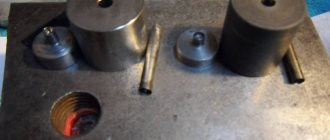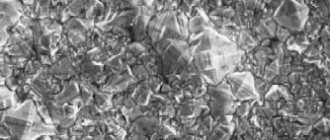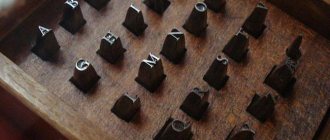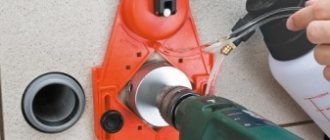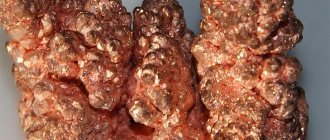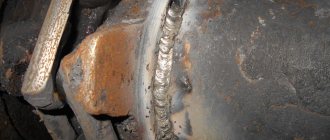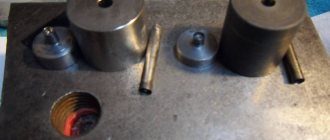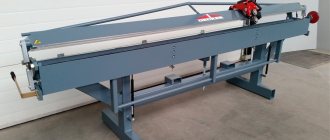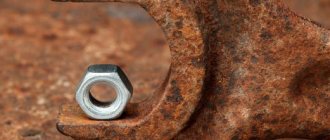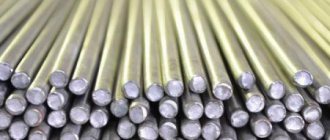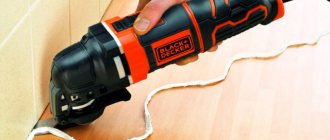Punching of sheet parts
The operation of the press by punching is quite simple.
In this case, one part of the material placed in the equipment is separated from the main one along a specific contour. The cutting process creates internal holes. The process of using stamps and punches for punching is reminiscent of cutting parts with scissors. In this case, the cutting components are the matrix and the punch, which have sharp edges. The drawing of the punch clearly shows how the metal is pressed into the lower part of the matrix, followed by bending and deformation of the material. Towards the end of the work, reaching maximum pressure, the metal fibers break and a corresponding cut is made on the product.
In the article we looked at what equipment such as a punch is made of, what it is and where it is used. With their help, coins, medals, badges, seals, textured designs, medicines and many other products are minted.
What are punches made of?
An important requirement for dies and punches is the competent choice of the material from which they will be produced. The worse the steel, the lower the productivity of the pressing equipment. Volumetric punches with complex shapes are made of high-chromium and high-carbon steel alloys. The most common material is steel marked X12F1. It has high wear resistance, excellent hardenability, and is not subject to significant deformation during operation. To produce simple types of dies, carbon tool steels U8A - U11A are used.
Parts made of heat-resistant metals retain their hardness during operation and do not lose their shape. In order to increase the durability of dies, materials from hard and high-speed alloys were introduced into production. The cutting edge is applied to the body of the die or die. The best results in the production of press parts were shown by alloys such as stalinite and stellite. They provide hardness to the elements without the need for hardening.
Working principle of the punch
At the moment of pressing, the punch begins to put pressure on the press washer, and it puts pressure on the workpiece, which is squeezed out through the matrix. Since the part operates under high power and thermal loads, it is made of special, wear-resistant steel. It is highly durable and does not deform
under the influence of temperature changes.
In principle, a punch can be called a tool that uses pressure to obtain a workpiece of a certain shape. In stamping production it is one of the most important parts.
If polyurethane is used together with it, then a matrix is made from it, which is the counter part of the stamp.
What materials are punches and dies made of?
In production, the punch is used as a press that forces the workpiece through the matrix. The system operates under high pressure, and during hot processes it is exposed to heat. In accordance with the main purpose, press parts are made from the following materials:
- For cold processes - from high-strength steels with increased hardenability (with a degree of hardening in the range of 54-65 HRC), as well as from tool steel grade 6ХВ2С. Materials must have high strength, wear resistance, and corrosion resistance. Alloy steels are not suitable for this type of structure, since after prolonged exposure to high temperatures the steel becomes brittle. Steel matrices have maximum hardness at a depth of at least half of its height and at a distance of at least 5 mm. along the entire working line, and the punches - along the entire height
- For hot processes - from wear-resistant steels with high strength at deformation temperatures. This ensures maximum stamp durability;
- Modern polymer materials - polyurethane - are also used. This is an elastic, wear-resistant and durable material with increased hardness - up to 98 units. according to the Shore scale.
What steels are punches made from?
The following steel grades are used for punches:
- U10A, X, X12M, X6VF, U8A and 8HF - for punching punches with a simple or complex shape of the cutting contour (56-60 HRC), stripping molds (X12M, X6VF with a hardness of 58-62 HCR).
- U8A, 8ХФ, Х12М and Х6ВФ - for bending and forming punches of simple shape (54-58 HRC) and complex shape (56-60 HRC).
- U10A, U10 or SCh 32-52 for drawing, flanging punches, as well as for the manufacture of parts from corrosion-resistant steel grades.
Steels 6ХВФ, Х12Ф1 and 7Х3 are used in the case of stamping of products from transformer steel and other hard materials.
Wood and metal processing
In dies for cold stamping (Fig. 1, a) only the forming parts, i.e., the punch and the matrix, are made of tool steel; in dies for hot stamping, either all parts are made from tool steel (Fig. 1, b), or only inserts (Fig. 1, c). Tool steels, hard alloys, plastics and other materials are used as materials for the form-building parts of dies.
Carbon tool steels U7, U8, U9 and U10 of reduced hardenability are used for the manufacture of dies and punches of dies for cold stamping, which have a simple shape of their working contour (in such dies there are no sharp transitions between elements; there are no narrow slots, thin bridges of metal between holes, etc. . P.). This is due to the fact that steels of reduced hardenability are deformed during hardening, resulting in the formation of cracks.
Punches and die matrices for cold stamping of more complex shapes are made from steel grades X, 9ХС, ХВГ, ХГС and other with increased hardenability.
Punches and die matrices for cold stamping of very complex shapes are made from steel grades X12F, X12T, X12M of high hardenability. These steels, similar in their properties to high-speed steels, contain about 1% carbon, 12% chromium and about 1% vanadium (titanium or molybdenum), and are characterized by high strength, wear resistance, and heat resistance (about 500°C). An important advantage of high-hardenability steels is low deformation and, therefore, the preservation of the dimensions of their working contour during hardening. Disadvantages include a tendency to carbide heterogeneity and poor machinability. X12F steel is almost 2.5 times more expensive than U10 carbon steel.
Thin and long punches of perforation dies for cold stamping and other non-rigid parts are made from steel grades 4ХС, 5ХС, 4ХВ2С, 5ХВ2С, etc. of high viscosity. The reduction in brittleness of these steels is achieved by reducing the carbon content (no more than 0.5%), and high wear resistance is determined by the presence of chromium and tungsten. The heat resistance of steels in this group is about 300 °C; They are quenched in oil; through quenching is obtained for samples with a diameter of up to 50 mm.
Concept and characteristics
The punch is the key element for marking the surface of a product using press pressure. This design is the same in size as the matrix profile (limiting box) and is used for extruding parts of a certain shape, marking a surface or stamping blanks.
Based on the type of impact on the material, the following types are distinguished:
- Punching and piercing punches are used to make a hole of a given shape in a flat workpiece;
- cutting or perforating punches are needed to cut a part of the required size and shape from the workpiece. They are also sometimes called jewelry.
Varieties and requirements
Standard punches differ in types: A, T, W and L. Also, depending on the products being manufactured, it is possible to use press dies of type B, C, D, etc., where the designation with a Latin letter indicates the type of fastening. Structurally, punches can be punched, perforated, pierced or punched.
The following requirements apply to the tools of vibropressing and stamping machines:
- No surface defects. It is unacceptable to use equipment with gaps, burrs, cracks or other damage.
- Timely replacement of equipment equipment. Punches have a limited service life, not exceeding 4-6 years, after which they must be replaced.
- Use only recommended steels in the manufacture of parts. During stamping or pressing, punches experience significant loads, therefore, depending on the type of operation (cold or hot processes), workpiece material, pressure applied and the purpose of the press plug itself, recommended steel grades are selected.
PLASMET LLC produces and sells various types of punches. Standard equipment for mounting on presses from most well-known manufacturers Gasparini, Ermaksan, Trumpf, Amada, LVD, etc. is available for sale. In addition to the supply of ready-made tools, we accept orders for the development and production of punches according to customer specifications. All products are manufactured in strict accordance with current requirements; hardening and anti-corrosion treatment are required.
To clarify your questions about the products presented and place an order for the supply or production of the required sheet-bending tools, call the phone number indicated on the website or leave a request online using the form.
Materials for the manufacture of punches and dies
The main task of a set of punches is to force the part through the matrix. This work is done under enormous pressure. When using hot pressing, the workpieces are exposed to high temperatures. Because of this, different types of materials are used to produce punches and dies. Devices for cold pressing are made from specialized high-strength steel, which has a high degree of hardening.
The materials for the manufacture of these parts meet the following characteristics:
- high degree of wear resistance;
- great strength;
- corrosion resistance.
Alloy steel is not suitable for high temperature applications. Metal can become brittle under the influence of temperature differences. Any punch has the highest degree of hardness over its entire height. In the hot method of manufacturing dies for steel stamping, the upper part of the product is made of specialized metals that are not subject to deformation at high temperatures and have a high degree of wear resistance. This technology can provide the greatest durability of the device. Sometimes modern types of various polymers are used. For example, it could be polyurethane, which has good elasticity and great strength.
Types and types of punches and dies
Types of punches differ in design, which is dictated by technological purpose:
- punched, perforated;
- cutting;
- piercing;
- molding;
- bending
Each type of tool is designed to perform operations; the catalog contains photos of punches of all types.
Punching punch: performs punching, cutting holes in sheet material, separates part of the material, forming an internal closed loop. Can be used for perforating sheet material. Often equipped with a release mechanism to release the cut-out part.
Cutting punch (cotter pin): separates the workpiece from the outer closed contour of the part. The punch of the cutting die, depending on the configuration, can cut out metal at angles from 1 degree, in 1-2 stages. The punch and die are most often used to work with material up to 1.5 mm thick.
Piercing punch for a press: creates holes (through/blind) in the workpiece by displacing metal. It can be solid/hollow, creating holes of small or large (500-800 mm) diameters, respectively.
Forming punch: creates a three-dimensional relief product of a closed contour from a metal sheet, often in one step.
Bending punch: bends metal along a given line, pressing into the workpiece to the required depth, thereby forming a bend.
The punch part can have different shapes: simple geometric (cylinder, hexagon, square, rectangle), or shaped (complex), which is used to create parts with a complex contour.
According to the type of its design, the matrix can be
- Solid matrix: for working with parts of a simple external contour.
- Complex matrix: for processing complexly contoured products.
- Prefabricated matrix: manufactured on high-precision machine equipment using a minimum of manual work. To start working, you just need to quickly and easily press its elements into the holder.
- Composite matrix: consists of several identical modules. It is used in molds with several cavities. Split bases are used if the future product has complex geometry. Most often, simple modules are used.
Depending on the characteristics of the product being manufactured, the punch and matrix can be used as complementary parts of a set, or separately. Thus, the base can be used without a punch if it is necessary to produce a part with a flat sole. In the production of building materials, in some cases its use is also not required: for example, when molding standard bricks, when surface quality is not important. If sheet material is stamped, the work can be carried out without a base module - only a flat base is placed under the workpiece.
What are punches made of?
An important requirement for dies and punches is the competent choice of the material from which they will be produced. The worse the steel, the lower the productivity of the pressing equipment. Volumetric punches with complex shapes are made of high-chromium and high-carbon steel alloys. The most common material is steel marked X12F1. It has high wear resistance, excellent hardenability, and is not subject to significant deformation during operation. To produce simple types of dies, carbon tool steels U8A - U11A are used.
Parts made of heat-resistant metals retain their hardness during operation and do not lose their shape. In order to increase the durability of dies, materials from hard and high-speed alloys were introduced into production. The cutting edge is applied to the body of the die or die. The best results in the production of press parts were shown by alloys such as stalinite and stellite. They provide hardness to the elements without the need for hardening.
How dies and punches work
During pressing, a durable tamping punch exerts strong pressure on a special press washer, which in turn transfers pressure to the workpiece. As a result, the desired workpiece is squeezed out through the matrix. The punch is capable of operating under enormous thermal and power loads, so it is made from wear-resistant metal. The device is very durable and is not damaged by temperature changes.
In other words, a die is considered a device that, using pressure, can produce a workpiece of the required shape and size. When stamping various parts, it is the most important tool. When polyurethane is used together with it, a high-quality matrix is made from it, which will be the response unit of the stamp.
When assembling any type of stamp, the design of this device always completely coincides with the cutting edge of the matrix. In other words, such a product is a closing unit that is capable of creating the upper part of the workpiece. A set of punches is a small press that can efficiently mark or stamp various components. Using this device, it is possible to produce blanks of any size or apply high-quality markings, which can be mirrored or regular.
Punch sets are used in metalworking plants that press iron blanks or produce sheet metal parts. In the construction industry, using this device, you can make aerated concrete blocks that have various voids.
The main purpose of the matrix
In order to make a workpiece of the required shape , a matrix is used, which can be made from:
To make an iron part, the matrix must be made of specialized strong steel, which has high wear resistance. Such a structure should be equipped with polished walls and not have a lid.
Experts distinguish the following types of matrices:
The most complex design solutions are used quite rarely, so they are produced to individual order. An example of simple matrices is molds for the production of various blocks and small bricks.
Making punches
In the production of punches, high-precision machines with program control are used. Initially, milling machines are used, which mechanically produce and process workpieces. Then they are polished and then, using metalworking equipment, the working contour of the stamp is applied to the surface. After the punch is made, it is placed in a special furnace for hardening.
The punches produced can be cylindrical or shaped, the production of which is subject to a longer and more complex process. Punches containing letters or numbers are also produced. This is a steel piece with a square cross-section, having a sawn tip, on which the required sign is engraved. A punch of this shape is used to brand various numbers, metal parts, machine elements and other products.
The matrix, in turn, is made after the punch, using its impression. The container should be slightly larger in width and size. Therefore, the required gap between the parts is adjusted by independent processing.
Press equipment parts wear out quickly, so they should be replaced periodically. The lifespan of punches is influenced by die manufacturing methods and production area. The average lifespan of press components is about 6 years.
Matrices
The matrix is a specialized box, thanks to which the workpiece takes on the required shape. For their production, high-quality steel or hard alloys are used. All walls of the matrix structure are located parallel to each other, and there is no cover. Manufacturers produce simple and combined products. The first option is used exclusively for the production of one specific product, and the second option is used for the production of several. Very often matrices are made to order.
The surface of the matrix is subject to a thorough grinding procedure, while all working parts undergo specialized heat treatment. In some cases, these products are coated with a protective coating to increase their service life. This solution significantly increases the service life.
What is a die and a punch?
A matrix is a box that forms the shape of a future product. Made from metal. The walls of the structure are strictly parallel to each other, there is no cover. There are simple (for only one type of product) and complex or combined (for two or more) matrices. The second type is rarely used; most often, these are special forms made to order. Simple matrices are widely used in the construction industry for the production of blocks and bricks with voids.
The punch is a special design that matches the profile of the matrix. This is the closing element with the help of which the product is formed from above. The punch performs the function of a press (another name is a press stamp or cotter pin), a stamp or a marking device. The system either extrudes the part, applies markings (regular or mirrored), or stamps the parts. The main area of application is metalworking, for example, metal pressing, production of construction products (aerated concrete blocks with shaped voids, cinder blocks) and much more.
Stamp and punch
In any stamp, the design of this part always coincides with the cutting part of the matrix.
In fact, this part can be called the closing part, creating the upper part of the product. A punch is a small press that is capable of stamping and marking parts. With its help, you can stamp parts of any shape or apply markings, and it can be ordinary or in a mirror image.
mainly used in the metalworking industry , where metal pressing is used and sheet blanks are formed. In the construction industry, aerated concrete blocks with shaped voids are produced using a punch.
How does the press work?
During operation, the punch (we discussed what it is at the beginning of the article), by applying pressure on a special washer, acts on a metal part, which in turn passes through the matrix. Thus, the required shape is prepared. During operation, parts of pressing equipment are subjected to enormous pressure, reaching up to 500 kg per 1 square meter. mm. They also constantly heat up to levels above 200 degrees. Due to this, stamping and press parts wear out. And due to the additional impact of the processed products, punches and dies lose hardness over time. Therefore, their durability depends on the material from which they are made.
Casting device: steel punch, copper matrix
In Russian technical literature, the block is called a punch (from the French poincon). In this case, German printers use the terms Schriftstempel or Schriftpragestempelt, and English printers use letter punch. By pressing the punch into a softer metal plate, a recessed, straight image of the type character is obtained. Such a metal plate is now called a matrix (German – Matrize, French – matrice, English – matrix). The matrix serves as a mold for casting typographical letters. It is obvious that with the help of one punch you can extrude a large number of identical dies, and from the same die you can cast many identical characters.
Matrix, punch (a) and letters (b)
This technology was known long before the time of Gutenberg and was tested for centuries in coin production, where metal stamps have long been used (Fig. 5.10). To make matrices, a metal was needed that, on the one hand, could be easily embossed, and on the other, would not soften when molten metal was poured into it, from which typographical type was made.
Lower (left) and upper (right) coin stamps. XVI century Hardened steel with a carbon content of 0.7...0.75% wt.
Copper has long been such a metal; the oldest matrices that have survived to this day are made from copper (they date back to the beginning of the 16th century). These matrices are kept in a museum in the Dutch city of Haarlem. The dies are made using punches engraved by master Henrik Pietersohn from Rotterdam.
The production of a typographic font was very labor-intensive, because punches and matrices had to be made for a very large number of characters, many times greater than the number of characters of the Latin alphabet. The inventor made each alphabet sign in many variations. His goal was to imitate handwritten texts as closely as possible, so that a printed book would resemble a manuscript. At the same time, the number of punches, and therefore the dies, was approaching a thousand.
The two dimensions of a letter had to be the same not only for all copies of the same letter, but also for all, without the slightest exception, characters of the same font. The punch engraver reproduces letter designs that are amazing in terms of the accuracy of their stylistic design (and size); but he would have, in addition, to ensure that both the height and the point match perfectly. Point size (from German kegel) is the size of the height of a letter or sign, including lower and upper descenders. When typing by hand, the point was measured through the height of the type plate on which the letter or sign is located. Point size is measured in typographic points. It is the point value in typographical points that is called the font size in relation to modern text editors. The engraver's work was extremely labor-intensive, but essentially ineffective in the final result. A special collapsible casting mold with movable walls was needed. Thus, it is the cast form that, in fact, is the core of the invention. Without this key device for the multiple reproduction of type, printing would not have become a relatively cheap and powerful means of disseminating information.
Letters typed into a line. Modern reconstruction of Gutenberg's letters
The movable wall made it possible, with different widths of letters of one size, to ensure their identical height, and the growth of the letter (i.e., the length of its stem), the same not only for a given size, but for all fonts, was automatically ensured by the dimensions of the device itself.
SHARE INTERESTING INFORMATION
Punching of sheet parts
The operation of the press by punching is quite simple. In this case, one part of the material placed in the equipment is separated from the main one along a specific contour. The cutting process creates internal holes. The process of using stamps and punches for punching is reminiscent of cutting parts with scissors. In this case, the cutting components are the matrix and the punch, which have sharp edges.
The drawing of the punch clearly shows how the metal is pressed into the lower part of the matrix, followed by bending and deformation of the material. Towards the end of the work, reaching maximum pressure, the metal fibers break and a corresponding cut is made on the product.
In the article we looked at what equipment such as a punch is made of, what it is and where it is used. With their help, coins, medals, badges, seals, textured designs, medicines and many other products are minted.
Main characteristics of the product
Absolutely any type of stamps has a certain warranty period. The main components of this device are the matrix and the punch, which wear out quite quickly. These units must be changed regularly because they can last about 5 years without replacement. The equipment of vibration presses and stamping devices has a different design. This is done so that it is possible to carry out various technical operations.
For this reason, extensive grinding is performed when producing cylindrical dies. Craftsmen do rough processing of the device, and then clean grinding. The device is sharpened and polished at the last stage of its manufacture.
To make shaped punches, a technological impression is used. The device is hardened in a hot oven for 10 minutes. Next, the final sanding begins. To obtain a product of complex shape, a large amount of specialized equipment is used. It is almost impossible to do without the use of milling and planing machines.
Similar equipment is needed for matrix production. When the molds for the press are made of very high quality, and the punch is equipped with an accurate cut line, the stamp will have a high degree of wear resistance and a long service life. Experts believe that making stamps with your own hands is very difficult. To do this, you need to have a lot of knowledge in the field of metal processing.
Steels used for the manufacture of main parts, both dies and molds, belong to the group of tool steels. The technological and mechanical properties of tool steels are determined by the presence of chemical elements included in the steel. Based on their chemical composition, tool steels are divided into carbon, alloy and high-speed. The latter are used primarily for the manufacture of cutting tools, and therefore are not considered further.
Making punches
In the production of punches, high-precision machines with program control are used. Initially, milling machines are used, which mechanically produce and process workpieces. Then they are polished and then, using metalworking equipment, the working contour of the stamp is applied to the surface. After the punch is made, it is placed in a special furnace for hardening.
The punches produced can be cylindrical or shaped, the production of which is subject to a longer and more complex process. Punches containing letters or numbers are also produced. This is a steel piece with a square cross-section, having a sawn tip, on which the required sign is engraved. A punch of this shape is used to brand various numbers, metal parts, machine elements and other products.
The matrix, in turn, is made after the punch, using its impression. The container should be slightly larger in width and size. Therefore, the required gap between the parts is adjusted by independent processing.
Press equipment parts wear out quickly, so they should be replaced periodically. The lifespan of punches is influenced by die manufacturing methods and production area. The average lifespan of press components is about 6 years.
